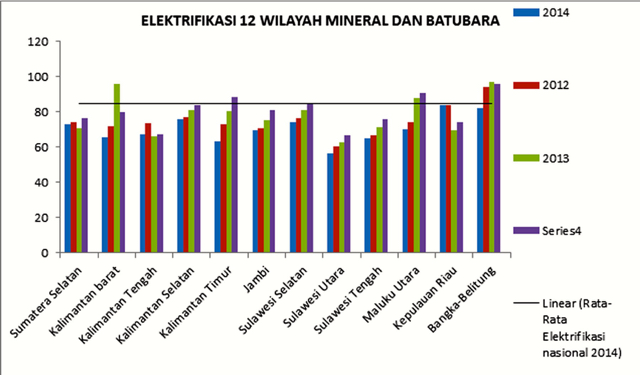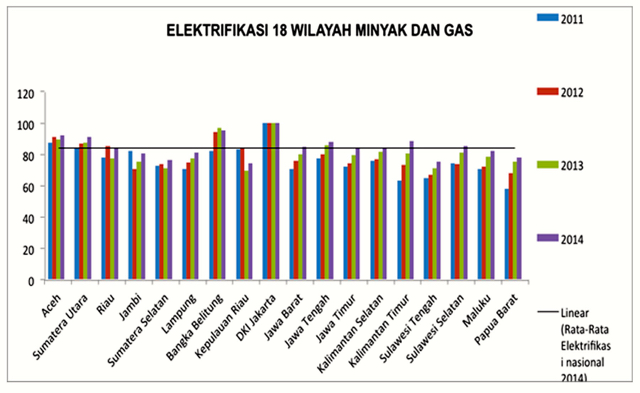
MONGABAY INDONESIA-The government of President Joko Widodo, promised to provide electricity to 47 border areas, which have been untouched so far. Although only 43 regions have been completed, the Ministry of Energy and Mineral Resources is sure that this plan can be completed this August. In fact, the symbolic inauguration will be held on 20 August 2015 in Saumlaki, West Southeast Maluku, Maluku. However, the power plant is still fueled by diesel (PLTD) even though the government promised it will only be temporary, before moving to renewable energy.
Jarman, Director General of Electricity at the Ministry of Energy and Mineral Resources (ESDM) said that out of 47 regions, 43 preparations have been completed, both for power plants and networks. “Just wait for the inauguration,” he said in Jakarta, last week. These areas are located on the borders and outer islands or remote areas in various regions in Indonesia, from Kalimantan, Timor, to Papua.
Towards the inauguration, he said, the government was still preparing technicalities, especially in Papua and North Kalimantan which are all the outer areas of Indonesia. The main obstacle in Papua is the difficulty in transportation access. In North Kalimantan, there is no water because of drought. We are trying hard to overcome these difficulties.”
To overcome this obstacle, ESDM, will prepare a helicopter. “If it is successful in all 47 regions, it means 34,178 new customers will have electricity.”
He said that while electricity uses PLTD, the use of renewable energy will be used for the future program. PLTD will be the backup system. That way, the costs will be cheaper and environmentally friendlier.
ESDM allocated a budget of IDR 1 trillion for the purchase and distribution of small-scale PLTD for 47 border areas and outer islands. From the total capacity of 60 megawatts (MW), each region gets different according to their needs.
Fabby Tumiwa, Executive Director of the Institute for Essential Service Reform, is worried that this program is just a quick operation, developed just to prove the President’s promise. He was worried about quality. “It is good that PLN handles this program, but you have to remember the expensive costs and remote locations. Don’t let there be a PLN operator later. “

Another problem is questioned. Can the power plant run 24 hours? “Usually six to eight hours per day is good. As long as it turns on every day. Don’t let it burn for a day, die for three days. People can be disappointed, later they think this is the image of the President. These operational matters need to be considered. “
Satya Widya Yudha, Commission VII DPR, via telephone reminded that this plan has been conducted since the previous government, but it has never been realized properly. He hopes that the current government can learn from past experiences. “Our intention is appreciated, time will tell.”
However, he said, there was no reason not to support the government’s move to penetrate the border areas.
Faby also reminded us that after 47 border areas were already electrified and we should think about facilities for the economic progress of that area also. “Not only electricity, the government must build clinics, health centers, and schools. Planning must be integrated and sustainable.”
Rich in energy, poor in electricity
Publish What You Pay Indonesia has just released the latest data regarding areas of electricity shortage in Indonesia. On average, this area is rich in oil and gas and mineral and coal (mineral and coal) mines. PWYP Indonesia noted, from 18 oil and gas producing provinces, the average electrification rate was below the national average, in 2014, amounting to 84.35.
A similar situation exists in areas rich in mineral and coal mining. Of the 12 main national mineral and coal mining producing provinces (70% of the national contribution), only four provinces have electrified more than the national average.
“The development pattern of electrification rates in areas rich in oil and gas and mineral and coal has fluctuated. Although the average trend is increasing, there is also a decline, even in a significant number such as West Kalimantan,” said Maryati Abdullah, Director of PWYP in a release.
The fluctuation situation and the differences between regions, also illustrates the unequal access to and services of electric energy in energy-rich regions. “This portrait becomes a note as well as a challenge for the government and various parties to answer the basic needs of areas rich in mining and energy sources.”

Source: http://www.mongabay.co.id/2015/08/16/pemerintah-pastikan-agustus-ini-47-daerah-perbatasan-teraliri-listrik-benarkah/